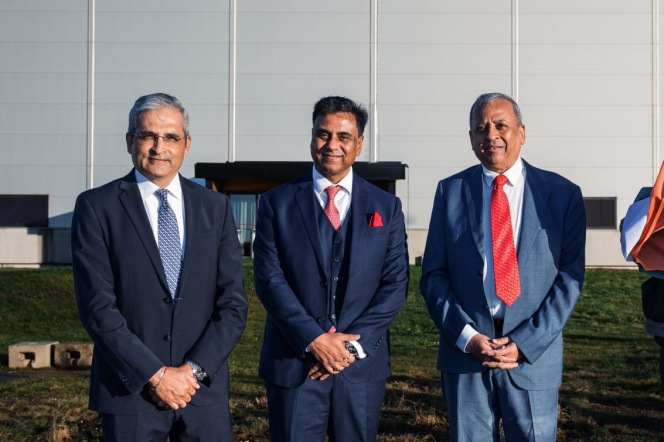Enhancing In-Cabin Experience With Smarter Chips
- By Gaurav Nandi
- January 20, 2025

Texas Instruments unveiled four integrated automotive chips in a virtual event, designed to reimagine in-cabin experience for both drivers and passengers. The high-tech chips were also showcased at the Consumer Electronics Show 2025 held in Las Vegas. The line-up included the AWRL6844 millimetre-wave radar sensor with AI-enhanced safety features, the AM275x-Q1 MCUs and the AM62D-Q1- a family of MCUs featuring the powerful C7X DSP core for premium audio- and the innovative TAS6754-Q1 audio amplifier with proprietary 1L modulation technology.
Alluding to the matter, a company official said, “The new-age automotive chips centre around advanced driver assistance systems (ADAS) and infotainment and cluster. As consumers, we expect a lot from our vehicles and this innovation is driven by two key factors. First, new government regulations and car assessment programmes mandate improvements in passenger safety, requiring more accurate and robust in-cabin sensing systems to monitor a variety of situations. Second, there is a growing demand for premium audio experiences as in-car systems now often surpass home audio systems in quality, delivering unparalleled experiences across a wide range of vehicles.”
“Our silicon solutions are designed to empower designers to enhance the overall in-vehicle experience without compromise. To that end, we are excited to debut three new automotive products,” he added.
Radar sensor
The AWRL6844 is designed to help customers deliver a safe and feature-rich user experience. It aims to enhance the user experience visually and improve safety. The company highlighted that OEMS face challenges in meeting stringent requirements while minimising cost and design complexity. Moreover, requirements for transference detection would award points only for direct sensing systems capable of detecting the presence of a human inside a vehicle by tracking signs of life such as artery aspiration rates and movements. Future in-cabin sensing systems would need to accurately differentiate between children and adults to enhance user experience and safety.
The AWRL6844 is the industry’s first single-chip solution that supports these three key applications, which has been achieved through the integration of AI into the silicon, claimed the company.
The sensor integration was said to provide optimal spatial resolution, delivering dense point cloud data for applications in a cost-effective manner while leveraging edge AI processing. This high-resolution data feeds into AI-driven algorithms on a customisable, on-chip auto accelerator and DSP, enabling local data processing. This approach, allows automotive systems to achieve advanced sensing with a single chip solution, reducing system cost and complexity.
The AWRL6844 will help OEMs could deliver seamless detection, validation and classification, simplifying sensing topologies and modalities used today or in the future.
For instance, the system can detect localised occupants with up to 98 percent accuracy to minimise detection errors. This eliminates uncertainty related to seatbelt detection when a non-human object is on the seat. When the car is parked, the sensor uses neural networks to classify adults and children with high accuracy, trained to detect micro-movements and distinguish between them. The device also enhances detection in blind spots, preventing children from being left unattended in vehicles.
Audio processor
On the other hand, the AM275x-Q1 MCU and AM62D-Q1 processors enable leveraging advanced audio features that enhance in-cabin experience. Another company official noted, “Audio is increasingly used in cars to enhance safety with features like door chimes and seatbelt reminders as well as to improve passenger comfort across vehicle fleets. These features are no longer limited to luxury vehicles. Our solutions bring premium audio capabilities across the entire OEM vehicle line-up, leveraging a unified software investment.”
“At the core of this innovation our C7x DSP core. It supports a higher number of speakers and multiple audio zones, delivering high-quality sound throughout the vehicle. The C7x DSP achieves 4-8 times the processing performance of competing devices, enabling the management of multiple audio features within a single core, thus reducing the need for external components,” the official added.
The C7x DSP’s performance is made possible by its 256-bit vector architecture and single-cycle memory access, alongside pipeline optimisations that drive industry-leading audio benchmarks. Additionally, the integrated neural processing unit allows customers to develop and execute AI algorithms on the same platform. This high processing capability reduces component requirements for automotive audio systems while enabling advanced features like real-time tuning, spatial audio and latency-reduced ANC.
“This is especially critical for EVs, which often lack passive sound-dampening materials, relying instead on active solutions to maintain cabin quietness. TI’s solutions also support Acoustic Vehicle Alerting Systems (AVAS) for external pedestrian alerts, making them integral to modern EV designs,” added the official.
The AM275x-Q1 MCU is a DDR-less single-chip solution tailored for high-performance audio applications, supporting up to 32 channels. Its integrated 4.5 MB SRAM and up to 6 MB L3 memory eliminate the need for external memory, reducing system complexity. In contrast, the AM62D-Q1 processor is DDR-based and suited for applications requiring large memory sizes such as high-resolution playback or simultaneous AI and audio processing. With a high-speed DDR4 controller, it ensures real-time compute capabilities and smooth performance.
The company claimed that both chips will enable engineers to design premium audio systems with minimal investment in hardware and software.
The TAS6754-Q1 Class D amplifier’s modulation technology reduces the number of required inductors by half. This advancement enables more compact, lightweight and cost-efficient designs without compromising audio quality. Additionally, the amplifier incorporates real-time load diagnostics, streamlining design processes and enhancing efficiency to meet OEM demands effectively.
Commenting on the new products, Senior Vice President of TI’s Embedded Processing Amichai Ron said, “Today’s drivers expect any car – entry-level to luxury, combustion to electric – to have enhanced in-cabin experiences. TI continues to provide innovative technologies to enable the future of the automotive driving experience. Our edge AI-enabled radar sensors allow automakers to make vehicles safer and more responsive to the driver, while our audio systems-on-chip elevate the drive through more immersive audio. Together they create a whole new level of in-cabin experiences.”
The chips are available at the company’s website.
- Tata AutoComp Systems
- International Automotive Components Group Sweden
- IAC Sweden
- Artifex Systems
- Arvind Goel
- Manoj Kolhatkar
- Anders Ericson
- Anurag Bhushan
- Jan Thesleff
- Sven Ostberg
Tata AutoComp Completes Acquisition Of IAC Sweden, Rebrands Entity As Artifex Systems
- By MT Bureau
- December 02, 2025

Tier 1 automotive supplier Tata AutoComp Systems has completed the acquisition of the assets of International Automotive Components Group Sweden (IAC Sweden), a European automotive component manufacturer specialising in interior and exterior systems. IAC Sweden has an annual turnover of approximately USD 800 million.
Under the Tata AutoComp Systems Group, the entity will operate as Artifex Systems.
This acquisition will strengthen Tata AutoComp’s presence in Europe and enhance its partnerships with key European OEMs across passenger and commercial vehicle segments. The integration combines design, engineering and system-level capabilities with manufacturing, precision painting and assembly expertise in the automotive space.
Arvind Goel, Vice-Chairman, Tata AutoComp Systems, said, “We are delighted to welcome IAC Sweden, now Artifex Systems AB, into the Tata AutoComp family. This transaction aligns with our long-term vision of strengthening our global presence and deepening our relationships with European OEMs. They have a rich legacy of delivering high-quality interior & exterior solutions, and together, we aim to build on that foundation. We have a well-defined plan to strengthen the Artifex brand by bringing together Artifex Systems AB, Artifex Slovakia, and Artifex Interior Systems under one cohesive and unified identity.”
Manoj Kolhatkar, MD & CEO, Tata AutoComp Systems, stated, “IAC Sweden, now Artifex Systems AB brings with it advanced manufacturing capabilities and a highly skilled workforce with deep expertise in automotive interior & exterior systems. Their strong commitment to quality complements Tata AutoComp’s focus on delivering value to global customers. We look forward to leveraging these strengths to enhance our competitiveness and expand our global footprint.”
Anders Ericson, Vice-President – Operations, Artifex Systems, said, "We are excited to begin this new chapter as part of the Tata AutoComp family, opening new opportunities for growth and collaboration. This marks a new phase of progress, bringing possibilities to strengthen our capabilities, expand our reach, and contribute to Tata AutoComp’s global vision."
Ambassador of India to Sweden, Anurag Bhushan, added, "I am pleased to see IAC Sweden, now Artifex Systems AB, becoming part of Tata AutoComp. I am confident that under Tata AutoComp, Artifex Systems will evolve and grow, driving economic growth in the region. This acquisition is also a reflection of the potentialities for collaboration between India and Sweden."
Jan Thesleff, Ambassador of Sweden to India, said, “The revitalisation of IAC Sweden (now Artifex Systems AB) by Tata AutoComp will ensure continuity for Swedish customers, safeguard employment, and strengthen manufacturing capability. We recognise the long-standing and strategic engagement of Tata AutoComp, a reputed company within the esteemed Tata Group, within Sweden’s industrial landscape. We welcome this development and value Tata AutoComp’s continued partnership in supporting the stability and growth of Sweden’s automotive ecosystem.”
Sven Ostberg, Consul General of Sweden in Mumbai, also added: “We are happy that IAC Sweden (now Artifex Systems AB) is now part of the Tata AutoComp Group. This development will help ensure the smooth functioning of the three plants, provide continued support for Swedish customers, and maintain continuity of employment, while further strengthening the resilience of Sweden’s automotive component ecosystem.”
Valeo Targets Tripling Sales In India To EUR 700 Million By 2028 Under Elevate 2028 Plan
- By MT Bureau
- November 20, 2025

French tier 1 supplier Valeo has outlined its new financial trajectory, ‘Elevate 2028,’ focusing on financial strength and growth, with a specific emphasis on expanding market share in key geographies, including India.
The company sees India as a market undergoing a deep transformation, perfectly positioning Valeo to benefit from increasing demand for advanced features and the electrification of vehicles.
Valeo expects significant growth in its Indian market operations over the plan's duration. The company forecasts its sales in India will nearly triple from EUR 220 million in 2024 to approximately EUR 700 million in 2028.
Globally, the Elevate 2028 plan aims to steadily improve profit, generate higher cash, and return to sales growth. The plan is powered by three ‘engines’: steadily increasing profit from 2022, generating higher cash from 2025 and returning to sales growth from 2027.
Christophe Perillat, CEO, Valeo, said, “Since 2022, our Move Up plan has ensured that we are well positioned in terms of technology to succeed in the market and has laid the foundations for significant financial improvements, resulting in a steady improvement in Group profit and cash. As we embark on the next stage with our Elevate 2028 plan, we intend to capitalise on these achievements and to further improve our financial fundamentals. To do this, our plan will be powered by three engines. The first engine is a steady increase in profit. It started in 2022 and will carry on delivering. The second engine, generating higher levels of cash, has just been fired. 2025 represents a turning point in the evolution of our business model and confirms our ability to generate more cash. The third engine will be the return to growth. It will kick in in 2027, as our strong order book translates into sales."
Tsuyo Manufacturing To Build EV Powertrain Plant And Testing Track In Karnataka
- By MT Bureau
- November 20, 2025

New Delhi-based EV powertrain startup Tsuyo Manufacturing has signed a Letter of Intent (LoI) with the Government of Karnataka to establish a new manufacturing plant and a large testing track for commercial vehicles in the state. The LoI was formalised at the Bengaluru Tech Summit 2025.
The new facility will focus on the design and production of heavy-duty EV powertrain systems for commercial and industrial applications. Key components to be developed and manufactured include: Electric Motors (across various topologies including IPMSM, ACIM, SRM, SynRM, and Axial Flux). E-Drives, E-Axles and Automatic Transmissions (AT), Integrated 2-in-1 and 3-in-1 Powertrain Solutions and Complete Powertrain Assemblies for heavy commercial EVs.
The facility will also include a dedicated Testing Track for the field testing and validation of buses, trucks, mining vehicles, and other heavy-duty EVs.
The plant's manufacturing capacity will range from 0.5 kW to 250 kW, with extended capability up to 600 kW through partnerships with CETL and LvKON.
The initiative is intended to strengthen India’s domestic manufacturing capabilities for high-performance EV powertrain systems, reducing reliance on imports. By producing motors, e-axles and integrated solutions, the facility will support the growth of India's commercial EV markets, including bus, truck and mining vehicles. The project is expected to create direct and indirect employment and boost industrial development in the state.
Vijay Kumar, Founder and CEO, Tsuyo Manufacturing, said, “This LoI marks a pivotal moment for Tsuyo and for the future of India’s EV ecosystem. Karnataka has always been at the forefront of innovation and advanced manufacturing, and we are proud to partner with the state to establish a facility that will redefine powertrain excellence for heavy commercial electric vehicles. With this investment, we aim to deliver world-class, reliable, and locally manufactured powertrain solutions that will power India’s transition to sustainable mobility.”
Priyank Kharge, Minister for Rural Development & Panchayat Raj, IT & Biotechnology, Government of Karnataka, said, “We are delighted that Tsuyo Manufacturing has decided to expand its Operations in Dharwad, Karnataka. Their decision reinforces our commitment to building a strong, local economy through LEAP (Local Economy Accelerator Program). This project will help building a sustainable ecosystem in the state and will attract more EV companies to come to our state - which is known for its Industry friendly policies and a dynamic EV ecosystem. This investment will not only create high-quality jobs in North Karnataka but also accelerate innovation and green mobility solutions for Karnataka and beyond.”
GST 2.0 And Trade Agreements Set To Reshape India's Auto Component Ecosystem Says Report
- By MT Bureau
- November 19, 2025

India’s automotive industry, which contributes 7.1 percent to the country’s GDP, is set for a transformation driven by regulatory changes, including GST 2.0 reforms, customs duty adjustments and the Indo–Japan Free Trade Agreement (CEPA) said a whitepaper by Grant Thornton Bharat and the Indo–Japan Chamber of Commerce and Industry (IJCCI). It highlights how these factors are reshaping the competitiveness of the USD 74 billion auto component sector.
The rollout of GST 2.0 in September 2025 has streamlined tax structures, boosting consumer demand across vehicle segments.
- Tax Rate Changes: Small cars and motorcycles under 350cc now face an 18 percent GST (down from 28 percent plus cess), leading to price reductions. Premium vehicles, including SUVs and high-end motorcycles, now have a flat 40 percent GST.
- EV Support: Electric vehicles (EVs) continue to benefit from a 5 percent GST rate.
- Consumer Response: Following the rate adjustments, the small car segment recorded a surge in vehicle deliveries, with booking volumes rising by nearly 50 percent.
- Supply Chain Incentives: Union Budget 2025 announced customs duty exemptions on lithium-ion battery scrap and critical minerals like lead and copper to secure raw materials and support the EV sector.
Sohrab Bararia, Partner, India Investment Advisory, Grant Thornton Bharat, said, “The convergence of GST 2.0 and targeted customs incentives marks a defining moment for India’s automotive sector. Reduced tax rates, simplified compliance, and supply-chain-focused exemptions will not only elevate India’s cost competitiveness but also strengthen its positioning as a manufacturing and export hub for Japanese automakers.”
The partnership between India and Japan, supported by USD 43.3 billion in Japanese investments, is deepening through trade agreements and skill development initiatives.
- Trade Agreements: The India–Japan CEPA and the India–Japan Digital Partnership (IJDP) are fostering innovation in EVs, connected vehicles and AI-led manufacturing.
- Skill Development: Initiatives like the Japan-India Institute for Manufacturing (JIM) are training over 30,000 Indian engineers to Japanese manufacturing standards.
- Exports: Car exports from India to Japan reached USD 616.45 million in the first nine months of FY2025.
Suguna Ramamoorthy, Secretary General Indo-Japan Chamber of Commerce and Industry, said, “There is significant partnership between India and Japan in the automotive sector, particularly in the realms of hybrid and electric vehicles, and high-precision components. The Free Trade Agreement (FTA) serves as a crucial catalyst for collaboration, joint research and development, and knowledge transfer, further supported by the India-Japan Industrial Competitiveness Partnership (IJICP). Recent initiatives have greatly advanced our automotive collaboration, especially in clean mobility and advanced manufacturing. The implementation of the GST 2.0 reform stands as a boon to Prime Minister Narendra Modi’s Atmanirbhar Bharat programme, fostering an environment conducive to growth.”
The sustained policy alignment under GST 2.0, customs reforms and deeper utilisation of the Indo–Japan FTA are expected to drive competitiveness and technology transfer, accelerating India’s journey toward an innovation-led automotive future.
Image for representational purpose only: Credit Mike van Schoonderwalt/Pexels






Comments (0)
ADD COMMENT